Key Gates Turbo 50, Turbo 80, Turbo 120, Turbo 160 User Manual
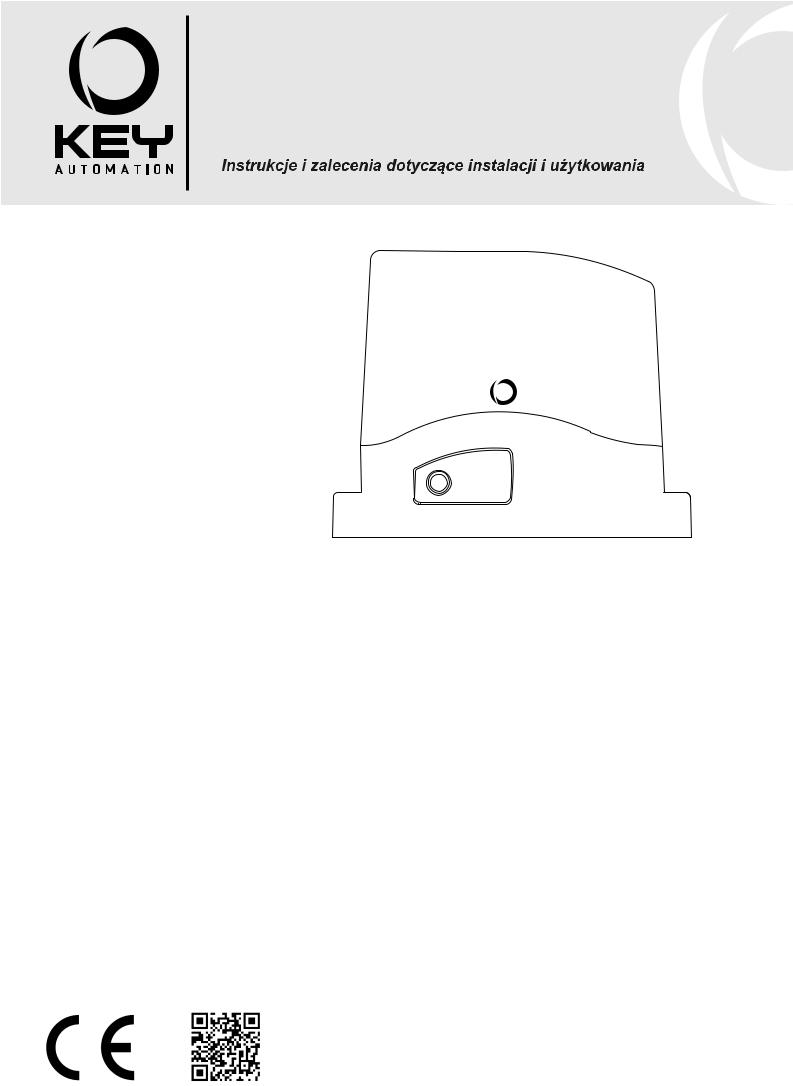
Istruzioni ed avvertenze per l’installazione e l’uso
Instructions and warnings for installation and use Instructions et avertissements pour l’installation et l’usage Instrucciones y advertencias para su instalación y uso Anleitungen und Hinweise zu Installation und Einsatz Instruções e advertências para a instalação e utilização
TURBO 50 - 80 - 120 -160
Motoriduttori per scorrevoli
Gear-motor for sliding gates
Motoreducteur pour coulissants
Motorreductores para rejas correderas
Getriebe für Schiebegitter
Motorredutores para portões de correr
Napęd silnikowy do bram przesuwnych
Management
System
ISO 9001:2008
www.tuv.com
ID 9105043769

IT
INDICE
1 |
|
|
|
|
|
|
Avvertenze per la sicurezza |
pag. 3 |
|||
|
|
|
|||
2 |
|
|
|
|
|
|
Introduzione al prodotto |
pag. 4 |
|||
|
|
|
|||
2.1 |
Descrizione del prodotto |
pag. 4 |
|||
2.2 |
Quadro d’insieme e caratteristiche tecniche |
pag. 4 |
|||
3 |
|
|
|
|
|
|
Verifiche preliminari |
pag. 6 |
|||
|
|
|
|||
4 |
|
|
|
|
|
|
Installazione del prodotto |
pag. 6 |
|||
|
|
|
|||
4.1 |
Funzionamento manuale |
pag. 6 |
|||
4.2 |
Installazione |
pag. 6 |
|||
4.3 |
Fissaggio |
pag. 7 |
|||
4.4 |
Fissaggio cremagliera |
pag. 7 |
|||
4.5 |
Fissaggio finecorsa |
pag. 8 |
|||
5 |
|
|
|
|
|
|
Collaudo e messa in servizio |
pag. 8 |
|||
|
|
|
|||
5.1 |
Collaudo |
pag. 8 |
|||
5.2 |
Messa in servizio |
pag. 8 |
|||
6 |
|
|
|
|
|
|
|
Istruzioni ed avvertenze destinate |
pag. 9 |
||
|
|
|
|||
|
|
|
all’utilizzatore finale |
|
|
7 |
|
|
|
|
|
|
|
Dichiarazione CE di conformità |
pag. 59 |
||
|
|
|
|||
2

IT
1 - AVVERTENZE PER LA SICUREZZA
ATTENZIONE – ISTRUZIONI ORIGINALI – importanti istruzioni di sicurezza. É importante per la sicurezza delle persone seguire le seguenti istruzioni di sicurezza. Conservare queste istruzioni.
Leggere attentamente le istruzioni prima di eseguire l’installazione.
La progettazione e la fabbricazione dei dispositivi che compongono il prodotto e le informazioni contenute nel presente manuale rispettano le normative vigenti sulla sicurezza. Ciò nonostante un’installazione e una programmazione errata possono causare gravi ferite alle persone che eseguono il lavoro e a quelle che useranno l’impianto. Per questo motivo, durante l’installazione, è importante seguire attentamente tutte le istruzioni riportate in questo manuale.
Non procedere con l’installazione se si hanno dubbi di qualunque natura e richiedere eventuali chiarimenti al Servizio Assistenza Key Automation.
Per la legislazione Europea la realizzazione di una porta automatica o un cancello automatico deve rispettare le norme previste dalla Direttiva 2006/42/CE (Direttiva Macchine) e in particolare, le norme EN 12445; EN 12453; EN 12635 e EN 13241-1, che consentono di dichiarare la conformità dell’automazione.
In considerazione di ciò, il collegamento definitivo dell’automatismo alla rete elettrica, il collaudo dell’impianto, la sua messa in servizio e la manutenzione periodica devono essere eseguiti da personale qualificato ed esperto, rispettando le istruzioni riportate nel riquadro
“Collaudo e messa in servizio dell’automazione”.
Inoltre, egli dovrà farsi carico di stabilire anche le prove previste in funzione dei rischi presenti e dovrà verificare il rispetto di quanto previsto da leggi, normative e regolamenti: in particolare, il rispetto di tutti i requisiti della norma EN 12445 che stabilisce i metodi di prova per la verifica degli automatismi per porte e cancelli.
ATTENZIONE - Prima di iniziare l’installazione, effettuare le seguenti analisi e verifiche:
verificare che i singoli dispositivi destinati all’automazione siano adatti all’impianto da realizzare. Al riguardo, controllare con particolare attenzione i dati riportati nel capitolo “Caratteristiche tecniche”. Non effettuare l’installazione se anche uno solo di questi dispositivi non è adatto all’uso;
verificare se i dispositivi acquistati sono sufficienti a garantire la sicurezza dell’impianto e la sua funzionalità;
eseguire l’analisi dei rischi che deve comprendere anche l’elenco dei requisiti essenziali di sicurezza riportati nell’Allegato I della Direttiva Macchine, indicando le soluzioni adottate. L’analisi dei rischi è uno dei documenti che costituiscono il fascicolo tecnico dell’automazione. Questo dev’essere compilato da un installatore professionista.
Considerando le situazioni di rischio che possono verificarsi durante le fasi di installazione e di uso del prodotto è necessario installare l’automazione osservando le seguenti avvertenze:
non eseguire modifiche su nessuna parte dell’automatismo se non quelle previste nel presente manuale. Operazioni di questo tipo possono solo causare malfunzionamenti. Il costruttore declina ogni responsabilità per danni derivanti da prodotti modificati arbitrariamente;
evitare che le parti dei componenti dell’automazione possano venire immerse in acqua o in altre sostanze liquide. Durante l’installazione evitare che i liquidi possano penetrare all’interno dei dispositivi presenti;
se il cavo di alimentazione risulta danneggiato esso deve essere sostituito dal costruttore o dal suo servizio di assistenza tecnica o
comunque da una persona con qualifica similare in modo da prevenire ogni rischio;
se sostanze liquide penetrano all’interno delle parti dei componenti dell’automazione, scollegare immediatamente l’alimentazione elettrica e rivolgersi al Servizio Assistenza Key Automation. L’utilizzo dell’automazione in tali condizioni può causare situazioni di pericolo;
non mettere i vari componenti dell’automazione vicino a fonti di calore né esporli a fiamme libere. Tali azioni possono danneggiarli ed essere causa di malfunzionamenti, incendio o situazioni di pericolo;
tutte le operazioni che richiedono l’apertura del guscio di protezione dei vari componenti dell’automazione, devono avvenire con la centrale scollegata dall’alimentazione elettrica. Se il dispositivo di sconnessione non è a vista, apporre un cartello con la seguente dicitura: “MANUTENZIONE IN CORSO”;
tutti i dispositivi devono essere collegati ad una linea di alimentazione elettrica dotata di messa a terra di sicurezza;
il prodotto non può essere considerato un efficace sistema di protezione contro l’intrusione. Se desiderate proteggervi efficacemente,
è necessario integrare l’automazione con altri dispositivi;
il prodotto può essere utilizzato esclusivamente dopo che è stata effettuata la “messa in servizio” dell’automazione, come previsto nel paragrafo “Collaudo e messa in servizio dell’automazione”;
prevedere nella rete di alimentazione dell’impianto un dispositivo di disconnessione con una distanza di apertura dei contatti che consenta la disconnessione completa nelle condizioni dettate dalla categoria di sovratensione III;
per la connessione di tubi rigidi e flessibili o passacavi utilizzare raccordi conformi al grado di protezione IP55 o superiore;
l’impianto elettrico a monte dell’automazione deve rispondere alle vigenti normative ed essere eseguito a regola d’arte;
si consiglia di utilizzare un pulsante di emergenza da installare nei pressi dell’automazione (collegato all’ingresso STOP della scheda di comando) in modo che sia possibile l’arresto immediato in caso di pericolo;
questo dispositivo non è destinato a essere usato da persone (bambini compresi) le cui capacità fisiche, sensoriali o mentali siano ridotte, oppure con mancanza di esperienza o di conoscenza, a meno che esse abbiano potuto beneficiare, attraverso l’intermediazione di una persona responsabile della loro sicurezza, di una sorveglianza o di istruzioni riguardanti l’uso del dispositivo;
prima di avviare l’automazione assicurarsi che le persone non siano nelle immediate vicinanze;
prima di procedere a qualsiasi operazione di pulizia e manutenzione dell’automazione eseguire la disconnessione dalla rete elettrica;
particolare attenzione per evitare lo schiacciamento tra la parte guidata ed eventuali elementi fissi circostanti;
i bambini devono essere sorvegliati per sincerarsi che non giochino con l’apparecchio.
ATTENZIONE - Il materiale dell’imballaggio di tutti i componenti dell’automazione deve essere smaltito nel pieno rispetto della normativa presente a livello locale.
ATTENZIONE - I dati e le informazioni indicate in questo manuale sono da ritenersi suscettibili di modifica in qualsiasi momento e senza obbligo di preavviso da parte di Key Automation
S.r.l.
3
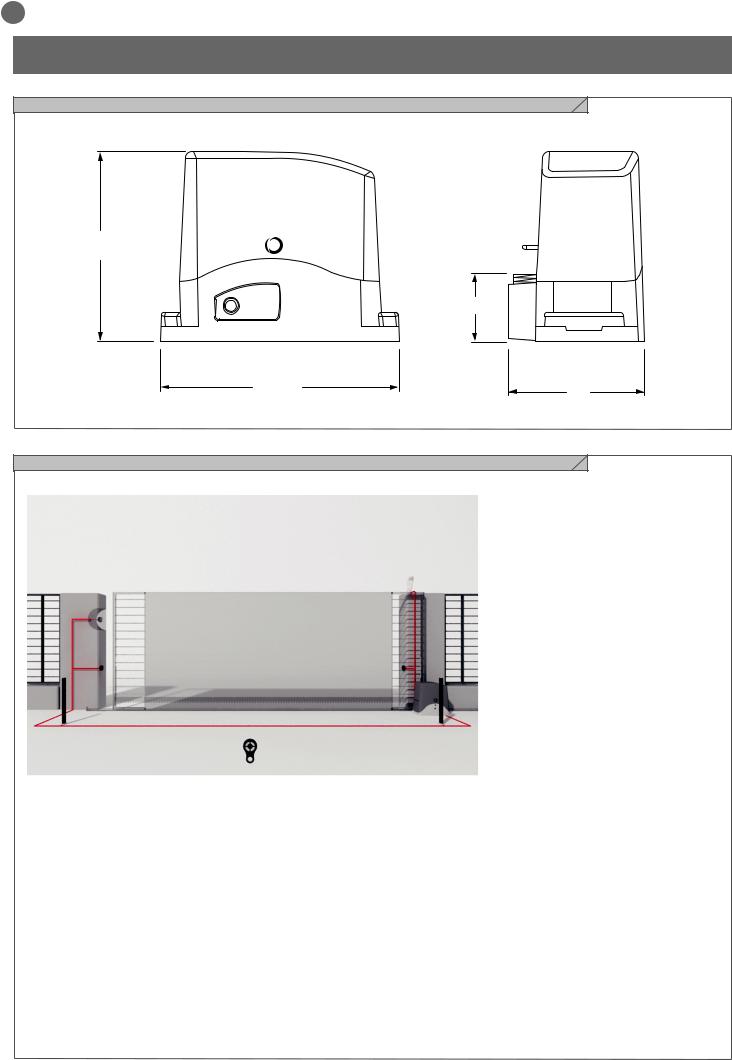
IT
2 - INTRODUZIONE AL PRODOTTO
2.1 - Descrizione del prodotto
Motoriduttore elettromeccanico irreversibile per cancelli scorrevoli con alimentazione a 24 Vdc e 230 Vac.
260
95
320 |
184 |
|
2.2 - Quadro d’insieme e caratteristiche tecniche
|
|
4 |
|
|
5 |
|
|
|
|
3 |
3 |
|
|
|
|
|
|
INSTALLAZIONE STANDARD |
|
|
2 |
|
1 |
Colonnina con fotocellula |
|
|
2 Automazione motoriduttore |
||
1 |
|
1 |
3 |
Fotocellula di rilevazione |
|
4 |
Lampeggiante di segnalazione |
||
6 |
|
|
||
|
|
5 |
Selettore a chiave |
|
|
|
|
6 Trasmettitore radio |
|
4
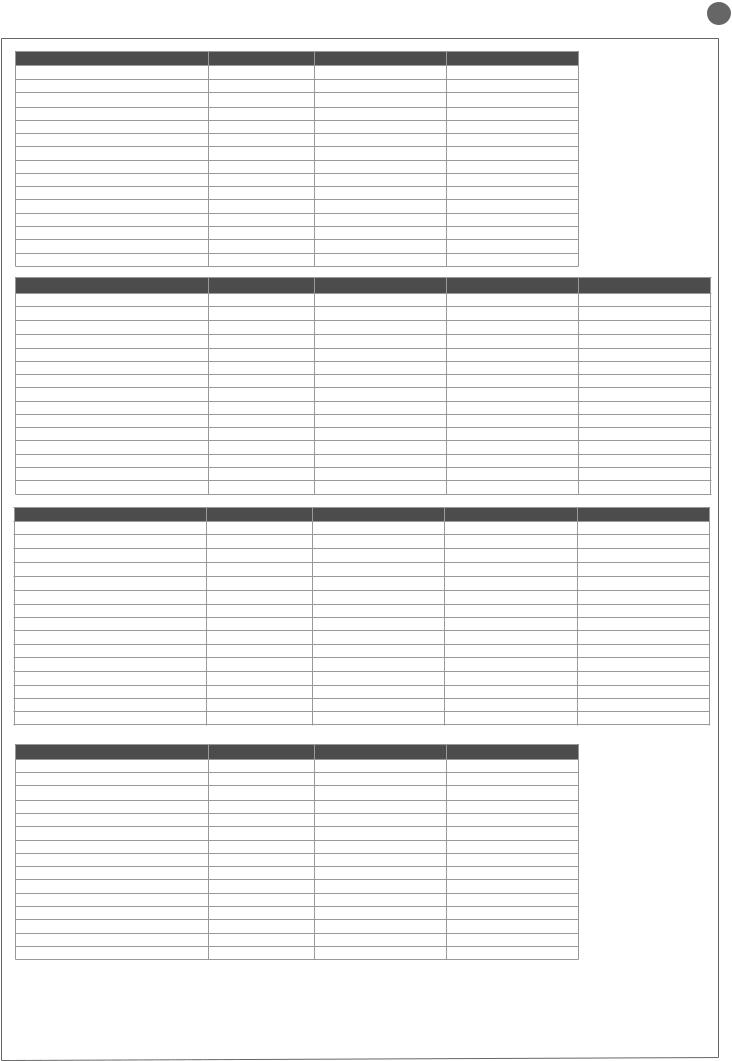
IT
DATI TECNICI |
|
TURBO 50 |
TURBO 50 |
Modello |
|
SC-40 |
SC52 |
velocità * |
cm/s |
16 |
16 |
coppia |
Nm |
16 |
16 |
ciclo di lavoro |
% |
30 |
30 |
centrale di comando |
|
- |
CT102 |
alimentazione |
Vac (Vdc) |
230 |
230 |
assorbimento motore |
A |
1,3 |
1,3 |
potenza assorbita |
W |
300 |
300 |
condensatore |
µF |
12,5 |
12 |
termoprotezione |
°C |
150 |
150 |
grado di protezione |
IP |
44 |
44 |
dimensione (L - P- H) |
mm |
320 - 184 - 260 |
320 - 184 - 260 |
peso |
kg |
12 |
12,5 |
temperatura di esercizio |
°C |
-20 +55 |
-20 +55 |
peso massimo cancello |
kg |
500 |
800 |
DATI TECNICI |
|
TURBO 80 |
TURBO 80 |
TURBO 80 |
Modello |
|
SC-50 |
SC82 |
SC7224 |
velocità * |
cm/s |
16 |
16 |
30 |
coppia |
Nm |
29 |
29 |
34 |
ciclo di lavoro |
% |
30 |
30 |
80 |
centrale di comando |
|
- |
CT102 |
CT10224 |
alimentazione |
Vac (Vdc) |
230 |
230 |
230 (24) |
assorbimento motore |
A |
1,9 |
1,9 |
2,5 |
potenza assorbita |
W |
450 |
450 |
500 |
condensatore |
µF |
16 |
16 |
- |
termoprotezione |
°C |
150 |
150 |
- |
grado di protezione |
IP |
44 |
44 |
44 |
dimensione (L - P- H) |
mm |
320 - 184 - 260 |
320 - 184 - 260 |
320 - 184 - 260 |
peso |
kg |
12,5 |
12,5 |
11 |
temperatura di esercizio |
°C |
-20 +55 |
-20 +55 |
-20 +55 |
peso massimo cancello |
kg |
800 |
800 |
700 |
DATI TECNICI |
|
TURBO 120 |
TURBO 120 |
TURBO 120 |
Modello |
|
SC-70 |
SC122 |
SC11224 |
velocità * |
cm/s |
16 |
16 |
23 |
coppia |
Nm |
40 |
40 |
50 |
ciclo di lavoro |
% |
30 |
30 |
80 |
centrale di comando |
|
- |
CT102 |
CT10224 |
alimentazione |
Vac (Vdc) |
230 |
230 |
230 (24) |
assorbimento motore |
A |
2,6 |
2,6 |
2,3 |
potenza assorbita |
W |
600 |
600 |
450 |
condensatore |
µF |
20 |
20 |
- |
termoprotezione |
°C |
150 |
150 |
- |
grado di protezione |
IP |
44 |
44 |
44 |
dimensione (L - P- H) |
mm |
320 - 184 - 260 |
320 - 184 - 260 |
320 - 184 - 260 |
peso |
kg |
13,5 |
13,5 |
11 |
temperatura di esercizio |
°C |
-20 +55 |
-20 +55 |
-20 +55 |
peso massimo cancello |
kg |
1200 |
1200 |
1100 |
DATI TECNICI |
|
TURBO 160 |
TURBO 160 |
Modello |
|
SC-100 |
SC162 |
velocità * |
cm/s |
16 |
16 |
coppia |
Nm |
40 |
40 |
ciclo di lavoro |
% |
30 |
30 |
centrale di comando |
|
- |
CT102 |
alimentazione |
Vac (Vdc) |
230 |
230 |
assorbimento motore |
A |
3 |
3 |
potenza assorbita |
W |
700 |
700 |
condensatore |
µF |
20 |
20 |
termoprotezione |
°C |
150 |
150 |
grado di protezione |
IP |
44 |
44 |
dimensione (L - P- H) |
mm |
320 - 184 - 260 |
320 - 184 - 260 |
peso |
kg |
14,5 |
14,5 |
temperatura di esercizio |
°C |
-20 +55 |
-20 +55 |
peso massimo cancello |
kg |
1600 |
1600 |
* Valore variabile in relazione al peso del cancello
5

IT
3 - VERIFICHE PRELIMINARI
Prima di installare il prodotto verificare e controllare i seguenti punti:
la struttura del cancello deve essere solida ed appropriata;
durante la corsa, il cancello non deve presentare eccessivi sbandamenti laterali;
il sistema di ruote/rotaia inferiore e rulli/guida superiore deve funzionare senza eccessivi attriti
per evitare il deragliamento del cancello devono essere installate le battute di arresto dello scorrevole, sia in apertura che in chiusura, e un secondo rullo/guida superiore nel pieno rispetto della normativa vigente;
nei cancelli preesistenti eliminare l’eventuale serratura manuale;
portare alla base del cancello le canaline di adduzione dei cavi di alimentazione (Ø25-50mm) e di collegamento esterno (fotocellula, lampeggiante, selettore a chiave, ecc.).
4 - INSTALLAZIONE DEL PRODOTTO
4.1 - Funzionamento manuale
Inserire la chiave e ruotarla in senso antiorario di 90°. |
Tirare la maniglia fino a portarla perpendicolare al motoriduttore. |
Fig. 2
N.B. Non azionare il motoriduttore prima di averlo ribloccato. L’aggancio con motore in movimento potrebbe danneggiare gli organi interni.
4.2 - Installazione
Rispettando le misure d’ingombro, fissare a terra la piastra di base mediante 4 robusti tasselli ad espansione (fig.3) oppure annegarla
nel calcestruzzo (fig.4).
Prevedere una o più guaine per il passaggio dei cavi elettrici.
Fig. 3 |
Fig. 4 |
N.B. E’ necessario conoscere le dimensioni della cremagliera per poter calcolare con precisione il posizionamento della contropiastra.
6
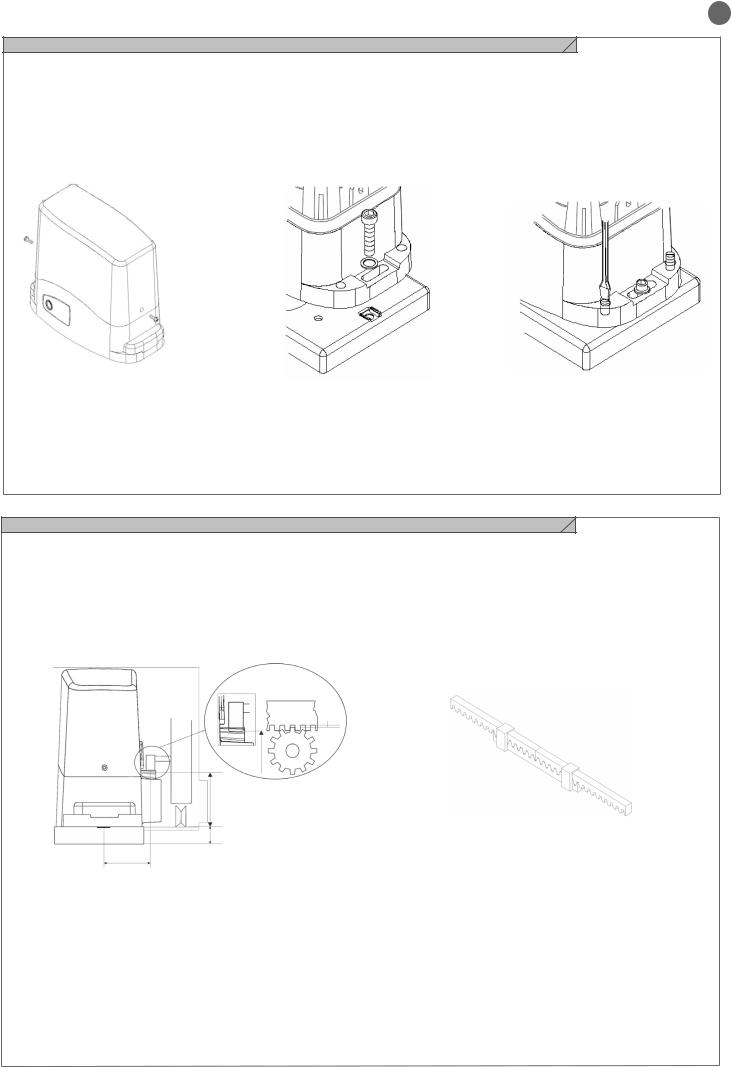
IT
4.3 - Fissaggio
Togliere il coperchio svitando le viti (fig.5). Appoggiare il motoriduttore sulla piastra. Inserire le due viti a brugola (fig.6).
E’ importante bloccare energicamente le due viti a brugola, assicurandosi che durante tutta la corsa del cancello il motoriduttore sia ben saldo a terra.
Qualora la regolazione consentita dalla cremagliera non fosse sufficiente, è possibile compensare l’altezza del motoriduttore agendo sulle quattro viti di regolazione (fig.7).
Si consiglia, dopo alcune manovre del motoriduttore, un ulteriore fissaggio delle viti.
Fig. 5 |
. 6 |
4.4 - Fissaggio cremagliera
Sbloccare il motoriduttore nel modo indicato in fig.2 e portare il cancello in completa apertura.
Appoggiare un elemento di cremagliera al pignone, e fissare lo stesso con viti e distanziali al cancello.
Spostare manualmente il cancello portando il pignone in corrispondenza dell’ultimo distanziale.
Fissare l’elemento di cremagliera definitivamente.
Per un corretto posizionamento degli altri elementi e garantire la loro rettilineità, è necessario utilizzare un elemento di cremagliera usandolo come appoggio e riferimento (fig.9). Bisogna garantire inoltre un’aria fra cremagliera e pignone di 2 mm così da non far gravare il peso del cancello sul pignone del motoriduttore (fig.8).
90mm
89mm |
89mm |
25mm |
|
2mm
Fig. 8
Fig. 9
7

IT
4.5 - Fissaggio finecorsa
Il cancello deve essere dotato di fermi di arresto in apertura e in chiusura che impediscano il deragliamento del cancello stesso.
La posizione del fermo d’arresto deve garantire che le staffe di finecorsa non entrino in collisione con il pignone.
Portare manualmente il cancello in apertura lasciando, a seconda
del peso del cancello, una luce da 30 a 50 mm tra il portone stesso e l’arresto meccanico.
Fissare la staffa del finecorsa mediante i grani (fig.11) in modo che il micro finecorsa sia premuto (fig.10).
Ripetere l’operazione con il portone in chiusura.
Fig. 10
Fig. 11
5 - COLLAUDO E MESSA IN SERVIZIO
Il collaudo dell impianto va eseguito da un tecnico qualificato che deve effettuare le prove richieste dalla normativa di riferimento in funzione dei rischi presenti, verificando il rispetto di quanto previsto
dalle normative, in particolare la norma EN12445 che indica i metodi di prova per gli automatismi per porte e cancelli.
5.1 - Collaudo
Tutti i componenti dell’impianto devono essere collaudati seguendo le procedure indicate nei rispettivi manuali di istruzioni;
controllare che siano rispettate le indicazioni del Capitolo 1 – Avvertenze per la sicurezza;
controllare che il cancello o la porta si possano muovere liberamente una volta sbloccata l’automazione e che siano in equilibrio e rimangano quindi fermi se lasciati in qualsiasi posizione;
controllare il corretto funzionamento di tutti i dispositivi collegati (fotocellule, bordi sensibili, pulsanti di emergenza, altro) effettuando delle prove di apertura, chiusura e arresto del cancello o della porta tramite i dispositivi di comando collegati (trasmettitori, pulsanti, selettori);
effettuare le misurazioni della forza d’impatto come previsto dalla normativa EN12445 regolando le funzioni di velocità, forza motore e rallentamenti della centrale nel caso in cui le misurazioni non diano i risultati desiderati fino a trovare il giusto settaggio.
5.2 - Messa in servizio
A seguito del positivo collaudo di tutti (e non solo di alcuni) i dispositivi dell’impianto si può procedere con la messa in servizio;
è necessario realizzare e conservare per 10 anni il fascicolo tecnico dell’impianto che dovrà contenere lo schema elettrico, il disegno o foto dell’impianto, l’analisi dei rischi e le soluzioni adottate, la dichiarazione di conformità del fabbricante di tutti i dispositivi collegati, il manuale istruzioni di ogni dispositivo e il piano di manutenzione dell’impianto;
fissare sul cancello o la porta una targa indicante i dati dell’automazione, il nome del responsabile della messa in servizio, il numero di matricola e l’anno di costruzione, il marchio CE;
fissare una targa che indichi le operazioni necessarie per sbloccare manualmente l’impianto;
realizzare e consegnare all’utilizzatore finale la dichiarazione di conformità , le istruzioni e avvertenze d’uso per l’utilizzatore finale e il piano di manutenzione dell’impianto;
accertarsi che l’utilizzatore abbia compreso il corretto funzionamento automatico, manuale e di emergenza dell’automazione;
informare anche in forma scritta l’utilizzatore finale sui pericoli e rischi ancora presenti;
ATTENZIONE - dopo la rilevazione di un ostacolo, il cancello o la porta si ferma in apertura e viene esclusa la chiusura automatica; per riprendere il movimento bisogna premere il pulsante di comando o usare il trasmettitore.
8

IT
6 - ISTRUZIONI ED AVVERTENZE DESTINATE ALL’UTILIZZATORE FINALE
Key Automation S.r.l. produce sistemi per l’automazione di cancelli, porte garage, porte automatiche, serrande, barriere per parcheggi e stradali. Key Automation non è però il produttore della vostra automazione, che è invece il risultato di un’opera di analisi, valutazione, scelta dei materiali, e realizzazione dell’impianto eseguita dal vostro installatore di fiducia. Ogni automazione è unica e solo il vostro installatore possiede l’esperienza e la professionalità necessarie ad eseguire un impianto secondo le vostre esigenze, sicuro ed affidabile nel tempo, e soprattutto a regola d’arte, rispondente cioè alle normative in vigore. Anche se l’automazione in vostro possesso soddisfa il livello di sicurezza richiesto dalle normative, questo non esclude l’esistenza di un “rischio residuo”, cioè la possibilità che si possano generare situazioni di pericolo, solitamente dovute ad un utilizzo incosciente o addirittura errato, per questo motivo desideriamo darvi alcuni consigli sui comportamenti da seguire:
•prima di usare per la prima volta l’automazione, fatevi spiegare dall’installatore l’origine dei rischi residui;
•conservate il manuale per ogni dubbio futuro e consegnatelo ad un eventuale nuovo proprietario dell’automazione;
•un uso incosciente ed improprio dell’automazione può farla diventare pericolosa: non comandate il movimento dell’automazione se nel suo raggio di azione si trovano persone, animali o cose;
•se adeguatamente progettato un impianto di automazione garantisce un alto grado di sicurezza, impedendo con i suoi sistemi di rilevazione il movimento in presenza di persone o cose, e garantendo un’attivazione sempre prevedibile e sicura. È comunque prudente vietare ai bambini di giocare in prossimità dell’automazione e per evitare attivazioni involontarie non lasciare i telecomandi alla loro portata.
•non appena notate qualunque comportamento anomalo da parte dell’automazione, togliete alimentazione elettrica all’impianto ed eseguite lo sblocco manuale. Non tentate da soli alcuna riparazione, ma richiedete l’intervento del vostro installatore di fiducia: nel frattempo l’impianto può funzionare come un’apertura non automatizzata, una volta sbloccato il motoriduttore con apposita chiave di sblocco data in dotazione con l’impianto. Con le sicurezze fuori uso è necessario far riparare quanto prima l’automatismo;
•in caso di rotture o assenza di alimentazione: attendete l’intervento del vostro installatore, o il ritorno dell’energia elettrica se l’impianto non è dotato di batterie tampone, l’automazione può essere azionata come una qualunque apertura non automatizzata. Per fare ciò è necessario eseguire lo sblocco manuale;
•sblocco e movimento manuale: prima di eseguire questa operazione porre attenzione che lo sblocco può avvenire solo quando l’anta è ferma.
•Manutenzione: Come ogni macchinario la vostra automazione ha bisogno di una manutenzione periodica affinché possa funzionare più a lungo possibile ed in completa sicurezza. Concordate con il vostro installatore un piano di manutenzione con frequenza periodica; Key Automation consiglia un intervento ogni 6 mesi per un normale utilizzo domestico, ma questo periodo può variare in funzione dell’intensità d’uso. Qualunque intervento di controllo, manutenzione o riparazione deve essere eseguito solo da personale qualificato.
•Non modificate l’impianto ed i parametri di programmazione e di regolazione dell’automazione: la responsabilità è del vostro installatore.
•Il collaudo, le manutenzioni periodiche e le eventuali riparazioni devono essere documentate da chi le esegue e i documenti conservati dal proprietario dell’impianto.
Gli unici interventi che vi sono possibili e vi consigliamo di effettuare periodicamente sono la pulizia dei vetrini delle fotocellule e la rimozione di eventuali foglie o sassi che potrebbero ostacolare l’automatismo. Per impedire che qualcuno possa azionare il cancello o la porta, prima di procedere, ricordatevi di sbloccare l’automatismo e di utilizzare per la pulizia solamente un panno leggermente inumidito con acqua.
• Al termine della vita dell’automazione, assicuratevi che lo smaltimento sia eseguito da personale qualificato e che i materiali vengano riciclati o smaltiti secondo le norme valide a livello locale.
Se il vostro trasmettitore dopo qualche tempo vi sembra funzionare peggio, oppure non funzionare affatto, potrebbe semplicemente dipendere dall’esaurimento della pila (a seconda dell’uso, possono trascorrere da diversi mesi fino ad oltre un anno). Ve ne potete accorgere dal fatto che la spia di conferma della trasmissione non si accende, oppure si accende solo per un breve istante.
Le pile contengono sostanze inquinanti: non gettarle nei rifiuti comuni ma utilizzare i metodi previsti dai regolamenti locali.
Vi ringraziamo per aver scelto Key Automation S.r.l. e vi invitiamo a visitare il nostro sito internet www.keyautomation.it per ulteriori informazioni.
9

EN
INDEX
1 |
|
|
|
|
|
|
Safety warnings |
pag. 11 |
|||
|
|
|
|||
2 |
|
|
|
|
|
|
Product overview |
pag. 12 |
|||
|
|
|
|||
2.1 |
Product description |
pag. 12 |
|||
2.2 |
Set panel and technical characteristics |
pag. 12 |
|||
3 |
|
|
|
|
|
|
Preliminary checks |
pag. 14 |
|||
|
|
|
|||
4 |
|
|
|
|
|
|
Installing the product |
pag. 14 |
|||
|
|
|
|||
4.1 |
Manual running |
pag. 14 |
|||
4.2 |
Installing |
pag. 14 |
|||
4.3 |
Fixing |
pag. 15 |
|||
4.4 |
Rack assembling |
pag. 15 |
|||
4.5 |
Limit switch fixing |
pag. 16 |
|||
5 |
|
|
|
|
|
|
Testing and commissioning |
pag. 16 |
|||
|
|
|
|||
5.1 |
Testing |
pag. 16 |
|||
5.2 |
Commissioning |
pag. 16 |
|||
6 |
|
|
|
|
|
|
|
Instructions and warnings for the |
pag. 17 |
||
|
|
|
|||
|
|
|
end user |
|
|
7 |
|
|
|
|
|
|
|
EC Declaration of Conformity |
pag.59 |
||
|
|
|
|||
10

EN
1 - SAFETY WARNINGS
CAUTION – ORIGINAL INSTRUCTIONS - important safety instructions. Compliance with the safety instructions below is important for personal safety. Save these instructions.
Read the instructions carefully before proceeding with installation.
The design and manufacture of the devices making up the product and the information in this manual are compliant with current safety standards. However, incorrect installation or programming may cause serious injury to those working on or using the system. Compliance with the instructions provided here when installing the product is therefore extremely important.
If in any doubt regarding installation, do not proceed and contact the
Key Automation Technical Service for clarifications.
Under European legislation, an automatic door or gate system must comply with the standards envisaged in the Directive 2006/42/EC (Machinery Directive) and in particular standards EN 12445; EN 12453; EN 12635 and EN 13241-1, which enable declaration of presumed conformity of the automation system.
Therefore, final connection of the automation system to the electrical mains, system testing, commissioning and routine maintenance must be performed by skilled, qualified personnel, in observance of the instructions in the “Testing and commissioning the automation system” section.
The aforesaid personnel are also responsible for the tests required to verify the solutions adopted according to the risks present, and for ensuring observance of all legal provisions, standards and regulations, with particular reference to all requirements of the EN 12445 standard which establishes the test methods for testing door and gate automation systems.
WARNING - Before starting installation, perform the following checks and assessments:
ensure that every device used to set up the automation system is suited to the intended system overall. For this purpose, pay special attention to the data provided in the “Technical specifications” section. Do not proceed with installation if any one of these devices is not suitable for its intended purpose;
check that the devices purchased are sufficient to guarantee system safety and functionality;
perform a risk assessment, including a list of the essential safety requirements as envisaged in Annex I of the Machinery Directive, specifying the solutions adopted. The risk assessment is one of the documents included in the automation system’s technical file. This must be compiled by a professional installer.
Considering the risk situations that may arise during installation phases and use of the product, the automation system must be installed in compliance with the following safety precautions:
never make modifications to any part of the automation system other than those specified in this manual. Operations of this type can only lead to malfunctions. The manufacturer declines all liability for damage caused by unauthorised modifications to products;
if the power cable is damaged, it must be replaced by the manufacturer or its after-sales service, or in all cases by a person with similar qualifications, to prevent all risks;
do not allow parts of the automation system to be immersed in water or other liquids. During installation ensure that no liquids are able to enter the various devices;
should this occur, disconnect the power supply immediately and contact a Key Automation Service Centre. Use of the automation system in these conditions may cause hazards;
never place automation system components near to sources of heat or expose them to naked lights. This may damage system components and cause malfunctions, fire or hazards;
all operations requiring opening of the protective housings of various automation system components must be performed with the control unit disconnected from the power supply. If the disconnect device is not in a visible location, affix a notice stating: “MAINTENANCE IN PROGRESS”:
connect all devices to an electric power line equipped with an earthing system;
the product cannot be considered to provide effective protection against intrusion. If effective protection is required, the automation system must be combined with other devices;
the product may not be used until the automation system “commissioning” procedure has been performed as specified in the “Automation system testing and commissioning” section;
the system power supply line must include a circuit breaker device with a contact gap allowing complete disconnection in the conditions specified by class III overvoltage;
use unions with IP55 or higher protection when connecting hoses, pipes or cable glands;
the electrical system upstream of the automation system must comply with the relevant regulations and be constructed to good workmanship standards;
users are advised to install an emergency stop button close to the automation system (connected to the control PCB STOP input) to allow the door to be stopped immediately in case of danger;
this device is not intended for use by persons (including children) with impaired physical, sensory or mental capacities, or with lack of experience or skill, unless a person responsible for their safety provides surveillance or instruction in use of the device;
before starting the automation system, ensure that there is no-one in the immediate vicinity;
before proceeding with any cleaning or maintenance work on the automation system, disconnect it from the electrical mains;
special care must be taken to avoid crushing between the part operated by the automation system and any fixed parts around it;
children must be supervised to ensure that they do not play with the equipment.
WARNING - The automation system component packaging material must be disposed of in full observance of current local waste disposal legislation.
WARNING - The data and information in this manual are subject to modification at any time, with no obligation on the part of Key Automation S.r.l. to provide notice.
11
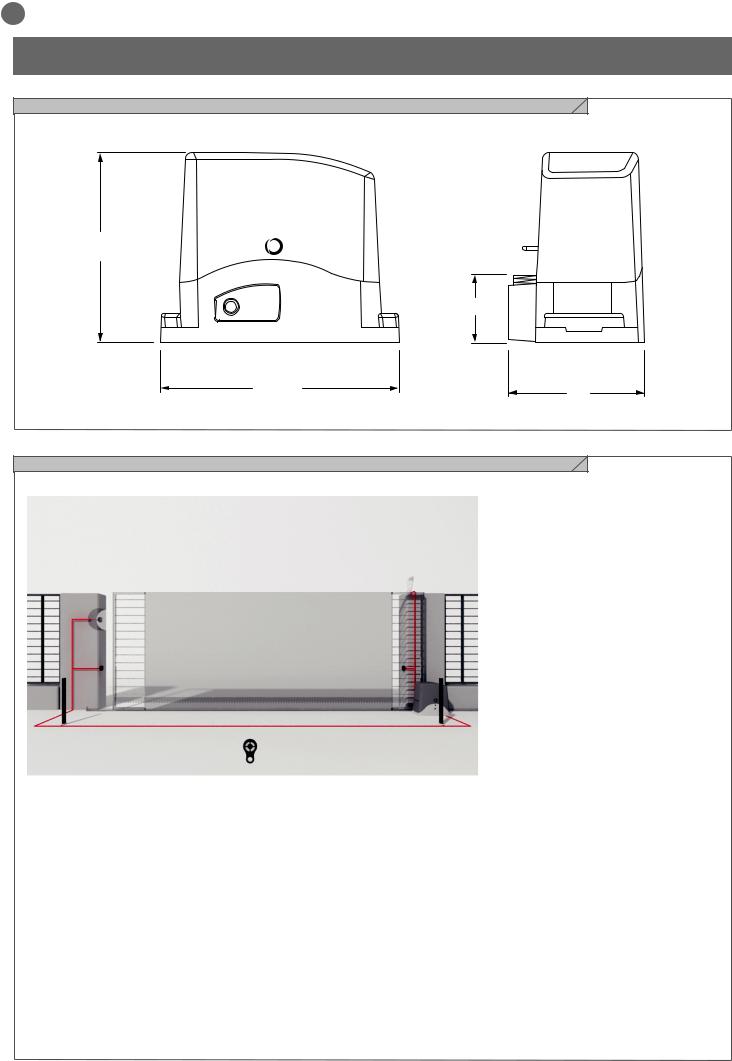
EN
2 - INTRODUCING THE PRODUCT
2.1 - Product description
Irreversible electromechanical gearmotor for sliding gates operating at 24 Vdc and 230 Vac.
260
95
320 |
184 |
|
2.2 - Set panel and and technical characteristics
|
4 |
|
|
5 |
|
|
|
3 |
3 |
|
|
|
|
STANDARD INSTALLATION |
|
|
2 |
1 |
Post for photocells |
|
2 Automation electromechanical |
||
1 |
1 |
3 |
Photocell detectors |
4 |
Flashing light |
||
6 |
|
5 |
Key switch |
|
|
6 |
Radio transmitter |
12
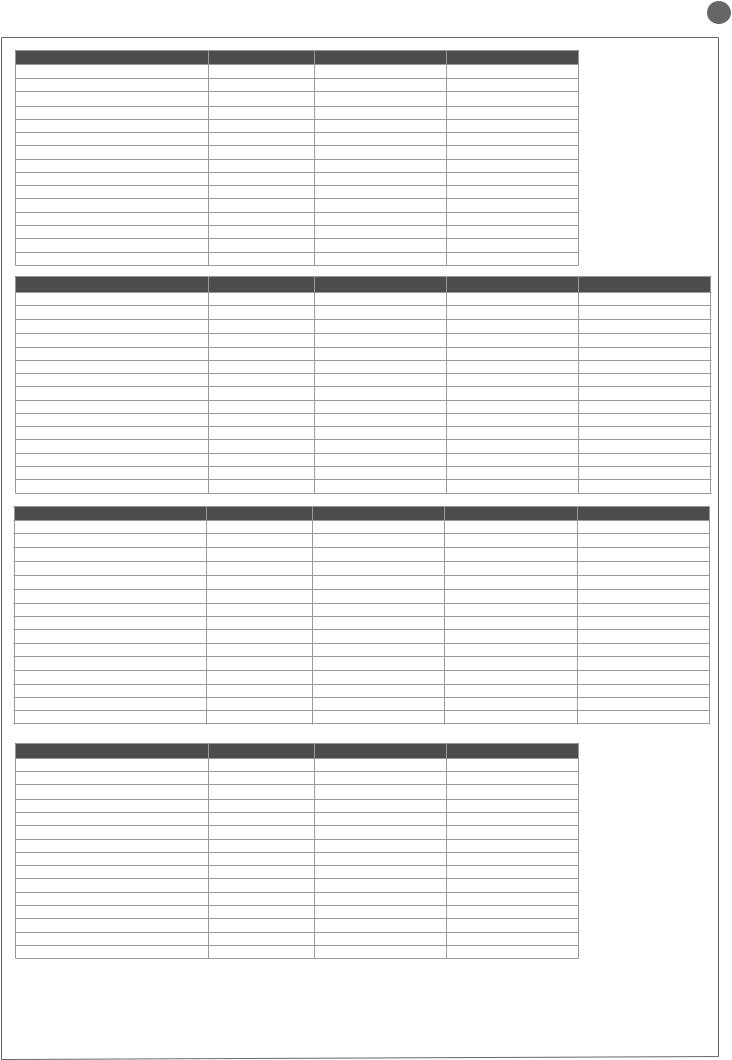
EN
TECHNICAL DATA |
|
TURBO 50 |
TURBO 50 |
Model |
|
SC-40 |
SC52 |
Speed* |
cm/s |
16 |
16 |
Torque |
Nm |
16 |
16 |
Working cycle |
% |
30 |
30 |
Control unit |
|
- |
CT102 |
Power |
Vac (Vdc) |
230 |
230 |
Motor consumption |
A |
1,3 |
1,3 |
Consumption power |
W |
300 |
300 |
Capacitor |
µF |
12,5 |
12 |
Thermoprotection |
°C |
150 |
150 |
Protection degree |
IP |
44 |
44 |
dimension (L - P- H) |
mm |
320 - 184 - 260 |
320 - 184 - 260 |
Weight |
kg |
12 |
12,5 |
Working temperature |
°C |
-20 +55 |
-20 +55 |
Max gate weight |
kg |
500 |
800 |
TECHNICAL DATA |
|
TURBO 80 |
TURBO 80 |
TURBO 80 |
Model |
|
SC-50 |
SC82 |
SC7224 |
Speed* |
cm/s |
16 |
16 |
30 |
Torque |
Nm |
29 |
29 |
34 |
Working cycle |
% |
30 |
30 |
80 |
Control unit |
|
- |
CT102 |
CT10224 |
Power |
Vac (Vdc) |
230 |
230 |
230 (24) |
Motor consumption |
A |
1,9 |
1,9 |
2,5 |
Consumption power |
W |
450 |
450 |
500 |
Capacitor |
µF |
16 |
16 |
- |
Thermoprotection |
°C |
150 |
150 |
- |
Protection degree |
IP |
44 |
44 |
44 |
dimension (L - P- H) |
mm |
320 - 184 - 260 |
320 - 184 - 260 |
320 - 184 - 260 |
Weight |
kg |
12,5 |
12,5 |
11 |
Working temperature |
°C |
-20 +55 |
-20 +55 |
-20 +55 |
Max gate weight |
kg |
800 |
800 |
700 |
TECHNICAL DATA |
|
TURBO 120 |
TURBO 120 |
TURBO 120 |
Model |
|
SC-70 |
SC122 |
SC11224 |
Speed* |
cm/s |
16 |
16 |
23 |
Torque |
Nm |
40 |
40 |
50 |
Working cycle |
% |
30 |
30 |
80 |
Control unit |
|
- |
CT102 |
CT10224 |
Power |
Vac (Vdc) |
230 |
230 |
230 (24) |
Motor consumption |
A |
2,6 |
2,6 |
2,3 |
Consumption power |
W |
600 |
600 |
450 |
Capacitor |
µF |
20 |
20 |
- |
Thermoprotection |
°C |
150 |
150 |
- |
Protection degree |
IP |
44 |
44 |
44 |
dimension (L - P- H) |
mm |
320 - 184 - 260 |
320 - 184 - 260 |
320 - 184 - 260 |
Weight |
kg |
13,5 |
13,5 |
11 |
Working temperature |
°C |
-20 +55 |
-20 +55 |
-20 +55 |
Max gate weight |
kg |
1200 |
1200 |
1100 |
TECHNICAL DATA |
|
TURBO 160 |
TURBO 160 |
Model |
|
SC-100 |
SC162 |
Speed* |
cm/s |
16 |
16 |
Torque |
Nm |
40 |
40 |
Working cycle |
% |
30 |
30 |
Control unit |
|
- |
CT102 |
Power |
Vac (Vdc) |
230 |
230 |
Motor consumption |
A |
3 |
3 |
Consumption power |
W |
700 |
700 |
Capacitor |
µF |
20 |
20 |
Thermoprotection |
°C |
150 |
150 |
Protection degree |
IP |
44 |
44 |
dimension (L - P- H) |
mm |
320 - 184 - 260 |
320 - 184 - 260 |
Weight |
kg |
14,5 |
14,5 |
Working temperature |
°C |
-20 +55 |
-20 +55 |
Max gate weight |
kg |
1600 |
1600 |
* Variable data according to gate weight
13
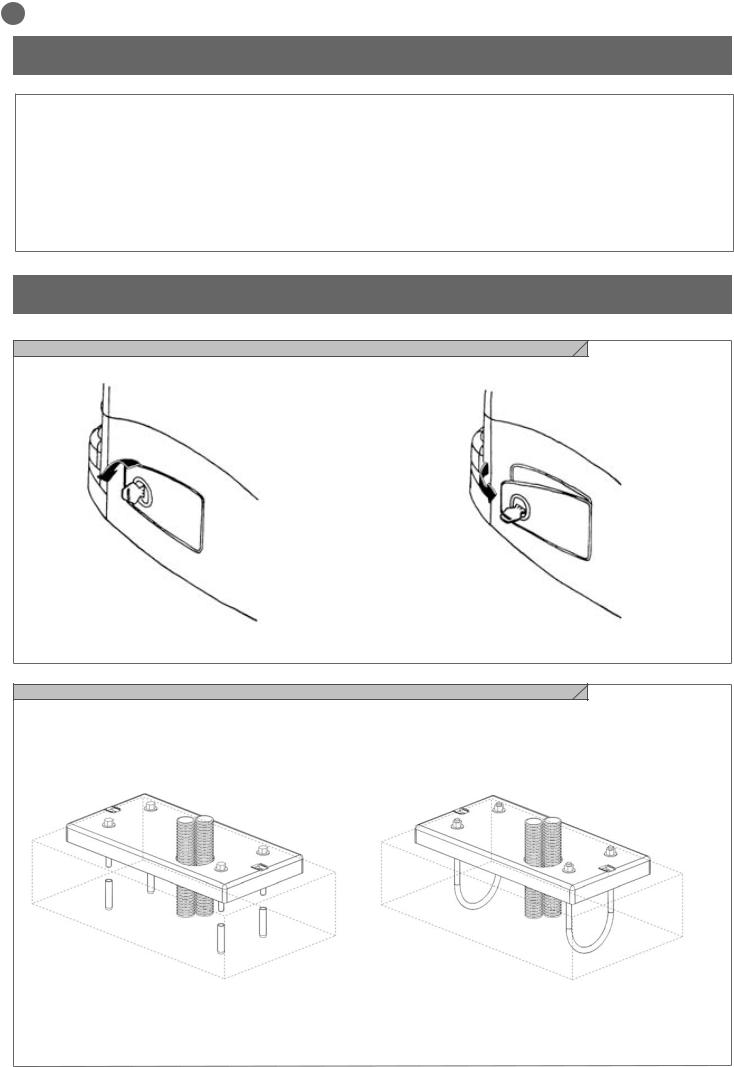
EN
3 - PRELIMINARY CHECKS
Before the installation starts, we suggest to carry out following inspections and operations:
the gate framework must be strong and suitable;
the gate must not show too many sideways slide skids during the running;
the system of wheels/lower rail and roller/upper runner must work without too many frictions;
to avoid the gate derailment you must install the stop beats of the sliding, whether at the opening or closing, and a second upper roller/runner in full observance of the current law;
remove any manual lock in the beforehand gates;
take on the gate bottom the feed raceway of the feeding cables
(Ø25-50mm) and of external connection (photocell, flash-light, key selector, etc...).
4 - INSTALLING THE PRODUCT
4.1 - Manual running
Insert the key and turn it 90° in anticlockwise direction. |
Pull the knob till it is perpendicular to the gearmotor. |
Fig. 2
N.B. Take care to re-engage the gearmotor before starting it up. Engaging with the motor running may damage its internal components.
4.2 - Installing
Respecting the overall size, fix to ground the base-plate through 4 sturdy screw-anchors (fig.3) or drown it into the concrete (fig.4).
Plan for one or more sheathing for the passage of the power lines.
Fig. 3 |
Fig. 4 |
N.B. The exact dimensions of the rack must be known to allow precise calculation of the counterplate position.
14
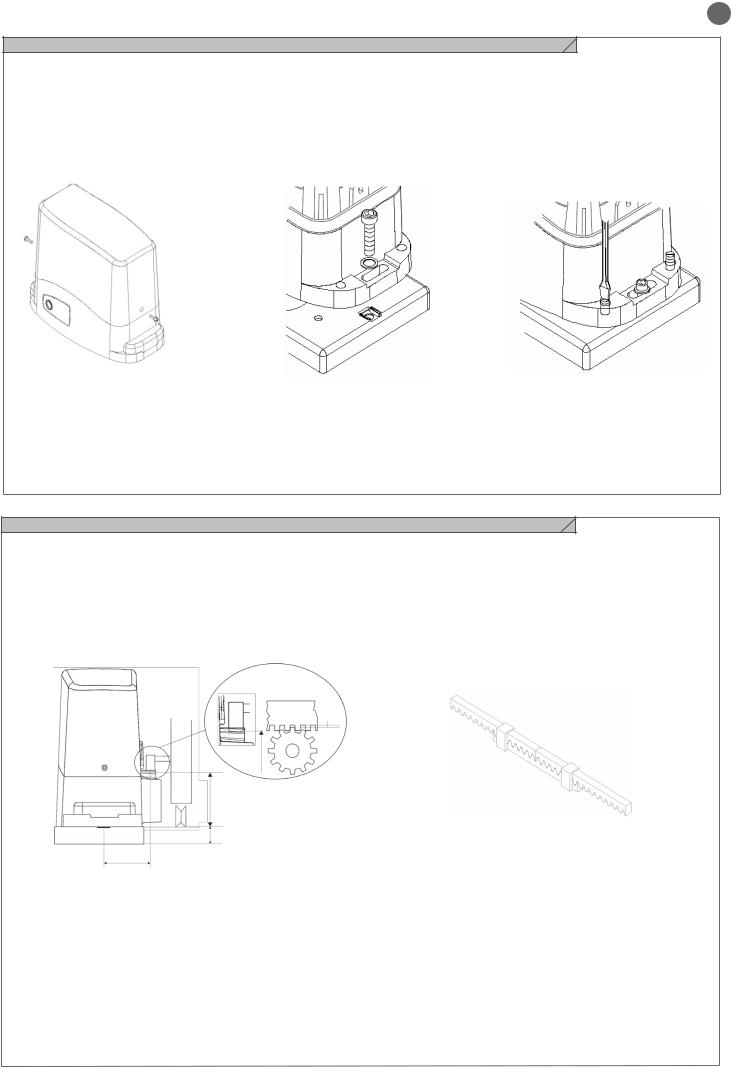
EN
4.3 - Fixing
Take the lid off unscrewing the screws (fig.5). Put the gearmotor on the plate. Insert the two socket head screws (fig.6).
It is important to lock the two socket head screws forcefully, making sure, that the gearmotor is steady on the ground, during the whole gate running.
If the regulating allowed by the rack is not sufficient, it is possible to counterbalance the gearmotor high working on the four screws
(fig.7).
The screws should be tightened again after the motor has been operated a few times.
Fig. 5 |
. 6 |
4.4 - Rack assembling
Release the gearmotor as indicated by the fig.2 and open entirely the gate.
Put a rack element on the pinion gear and fasten it to the gate with screw and spacing bars.
Move the gate manually bringing the pinion gear into line with the last spacing bar.
Fasten the rack element for good.
For a correct positioning of the other elements and to assure their straightness, it is necessary to employ a rack element using it as support and reference (fig.9).
It is besides necessary to assure an aperture of 2 mm between rack and pinion gear, so that the gate weight doesn’t rest on the gearmotor pinion gear (fig.8).
90mm
89mm |
89mm |
25mm |
|
2mm
Fig. 8
Fig. 9
15
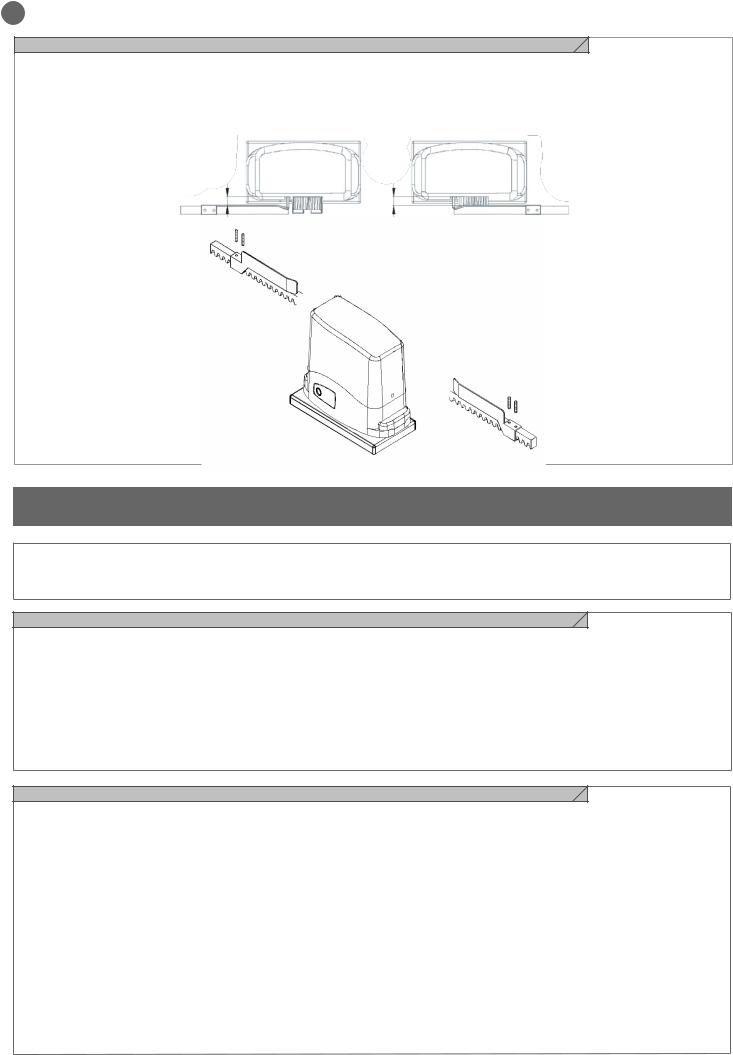
EN
4.5 - Limit switch fixing
The gate has to be equipped with stop locks at the opening and closing, which prevent the gate derailment.
The stop lock position must assure that the limit switch brackets don’t collide with the pinion gear.
Haul the gate manually at the opening leaving, depending on the
gate weight, a crack from 30 to 50 mm between the main gate and mechanical stop.
Fasten the limit switch bracket through the dowels (fig.11) so that the limit switch is pressed (fig.10).
Repeat the operation with the main gate at the closing.
Fig. 10
Fig. 11
5 - TESTING AND COMMISSIONING THE AUTOMATION SYSTEM
The system must be tested by a qualified technician, who must perform the tests required by the relevant standards in relation to the risks present, to check that the installation complies with
5.1 - Testing
the relevant regulatory requirements, especially the EN12445 standard which specifies the test methods for gate and door automation systems.
All system components must be tested following the procedures described in their respective operator’s manuals;
ensure that the recommendations in Chapter 1 - Safety Warnings - have been complied with;
check that the gate or door is able to move freely once the automation system has been released and is well balanced, meaning that it will remain stationery when released in any position;
check that all connected devices (photocells, sensitive edges, emergency buttons, etc.) are operating correctly by performing gate or door opening, closing and stop tests using the connected control devices (transmitters, buttons or switches);
perform the impact measurements as required by the EN12445 standard, adjusting the control unit’s speed, motor force and deceleration functions if the measurements do not give the required results, until the correct setting is obtained.
5.2 - Commissioning
Once all (and not just some) of the system devices have passed the testing procedure, the system can be commissioned;
the system’s technical dossier must be produced and kept for 10 years. It must contain the electrical wiring diagram, a drawing or photograph of the system, the analysis of the risks and the solutions adopted to deal with them, the manufacturer’s declaration of conformity for all connected devices, the operator’s manual for every device and the system maintenance plan;
fix a dataplate with the details of the automation, the name of the person who commissioned it, the serial number and year of construction and the CE marking on the gate or door;
also fit a sign specifying the procedure for releasing the system by hand;
draw up the declaration of conformity, the instructions and precautions for use for the end user and the system maintenance plan and consign them to the end user;
ensure that the user has fully understood how to operate the system in automatic, manual and emergency modes;
the end user must also be informed in writing about any risks and hazards still present;
WARNING - after detecting an obstacle, the gate or door stops during its opening travel and automatic closure is disabled; to restart operation, the user must press the control button or use the transmitter.
16

EN
6 - INSTRUCTIONS AND WARNINGS FOR THE END USER
Key Automation S.r.l. produces systems for the automation of gates, garage doors, automatic doors, roller blinds and car-park and road barriers. However, Key Automation is not the manufacturer of your complete automation system, which is the outcome of the analysis, assessment, choice of materials and installation work of your chosen installer. Every automation system is unique, and only your installer has the experience and skill required to produce a safe, reliable, durable system tailored to your needs, and above all that complies with the relevant regulatory standards. Although your automation system complies with the regulation safety level, this does not rule out the presence of “residual risk”, meaning the possibility that hazards may occur, usually due to reckless or even incorrect use. We would therefore like to give you some advice for the correct use of the system:
•before using the automation system for the first time, have the installer explain the potential causes of residual risks to you;
•keep the manual for future reference, and pass it on to any new owner of the automation system;
•reckless use and misuse of the automation system may make it dangerous: do not operate the automation system with people, animal or objects within its range of action;
•a properly designed automation system has a high level of safety, since its sensor systems prevent it from moving with people or obstacles present so that its operation is always predictable and safe. However, as a precaution children should not be allowed to play close to the automation system, and to prevent involuntary activation, remote controls must not be left within their reach;
•as soon as any system malfunction is noticed, disconnect the electricity supply and perform the manual release procedure. Never attempt repairs on your own; call in your installation engineer. In the meantime the door or gate can be operated without automation once the geared motor has been released using the release key supplied with the system. In the event of safety devices out of service arrange for repairs to the automation immediately;
•in the event of malfunctions or power failures: while waiting for the engineer to come (or for the power to be restored if your system is not equipped with buffer batteries), the door or gate can be used just like any non-automated installation. To do this, the manual release procedure must be carried out;
•manual release and operation: first bear in mind that the release procedure can only be carried out with the door or gate stationery.
•Maintenance: Like any machine, your automation system needs regular periodic maintenance to ensure its long life and total safety. Arrange a periodic maintenance schedule with your installation engineer. Key Automation recommends that maintenance checks should be carried out every six months for normal domestic use, but this interval may vary depending on the level of use. Any inspection, maintenance or repair work must only be carried out by qualified staff.
•Never modify the automation system or its programming and setup parameters: this is the responsibility of your installation engineer.
•Testing, routine maintenance and any repairs must be recorded by the person who performs them and the documents must be conserved by the system’s owner.
The only procedures you are capable of, and which you are recommended to perform, are cleaning of the photocell glass and removal of any leaves or stones that may obstruct the automation system.
To prevent anyone from activating the gate or door, release the automation system before starting. Clean only with a cloth dipped in a little water.
At the end of its useful life, the automation system must be dismantled by qualified personnel, and the materials must be recycled or disposed of in compliance with the legislation locally in force.
If after some time your remote control seems to have become less effective, or stops operating completely, the battery may be flat (depending on the level of use, this may take from several months up to more than a year). You will realise this because the transmission confirmation light does not come on, or only lights up for a very short time.
Batteries contain pollutants: do not dispose of them with normal waste but follow the methods specified by the local regulations.
Thank you for choosing Key Automation S.r.l.; please visit our Internet site www.keyautomation.it for further information.
17

FR
TABLE DES MATIÈRES
1 |
|
|
|
|
|
|
Consignes de sécurité |
page 19 |
|||
|
|
|
|||
2 |
|
|
|
|
|
|
Présentation du produit |
page 20 |
|||
|
|
|
|||
2.1 |
Description du produit |
page 20 |
|||
2.2 |
Tableau d’ensemble et caractéristiques |
page 20 |
|||
|
|
|
techniques |
|
|
3 |
|
|
|
|
|
|
Vérifications préalables |
page 22 |
|||
|
|
|
|||
4 |
|
|
|
|
|
|
Installation du produit |
page 22 |
|||
|
|
|
|||
4.1 |
Fonctionnement manuel |
page 22 |
|||
4.2 |
Installation |
page 22 |
|||
4.3 |
Fixation |
page 23 |
|||
4.4 |
Pose de la crémaillère |
pag3 23 |
|||
4.5 |
Fixation des dispositifs de fin de course |
page 24 |
|||
5 |
|
|
|
|
|
|
Réception et mise en service |
page 24 |
|||
|
|
|
|||
5.1 |
Réception |
page 24 |
|||
5.2 |
Mise en service |
page 24 |
|||
6 |
|
|
|
|
|
|
|
Instructions et avertissements |
page 25 |
||
|
|
|
|||
|
|
|
destinés à l’utilisateur final |
|
|
7 |
|
|
|
|
|
|
|
Déclaration CE de conformité |
page 59 |
||
|
|
|
|||
18
